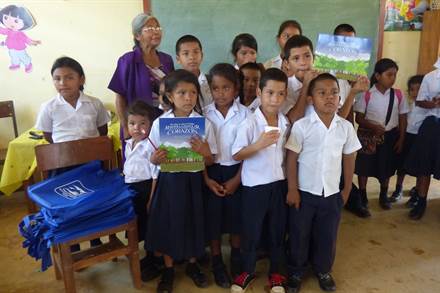
Pequeños Guardianes del Manglar
-
Conservación de humedales costeros
-
Resiliencia costera
Wetlands International Latin America & Caribbean is hoping to create a partnership with an elementary school in the community of El María, Remedios, a tiny village near the coast in the Chiriquí province of Panama. With several partners, the organization has begun a mangrove-climate change project in the region that will involve scientific research, influencer outreach, education and micro-enterprise support.

A school partnership would help the Remedios children understand how valuable mangroves are to the environment and to livelihoods that depend upon fishing and ecotourism. Wetlands International aims to replicate its great success in Chame, a rural community west of Panama City.
I visited the Chame school last May with Wetlands International’s communications director and a small group from TCU. We watched 11-year-olds explain how mangroves protect coastal communities by serving as a buffer during extreme weather, and about how mangroves provide a haven for tiny shellfish, birds, monkeys and other wildlife. The pre-teens, dressed in neatly pressed school uniforms, drew pictures on a whiteboard to demonstrate their knowledge of the mangrove root structure. They explained how mangroves absorb carbon dioxide from the atmosphere and help counter the effects of climate change. The entire class performed happy songs about the mangroves and invited us to the front of the class to participate in a skit that they wrote. The TCU students, school children and I pretended to be fish, waves, wind and mangroves in a living demonstration of the interaction of all these elements. Later, a group of first- and second-graders escorted us behind the school to see an open-air nursery where they are caring for mangrove seedlings until they are sturdy enough to be planted (by the children, of course) in a nearby coastal forest.
The children conveyed pride and a deep understanding of mangroves and their importance. It was obvious to me that the Chame school’s teachers have created an ingenious curriculum that uses music, art and even theater to advance the students’ understanding of the mangroves.
Wetlands International hopes the Remedios school will become a similar incubator of environmentally minded young citizens. The school’s principal and teachers expressed strong interest and said they would seek the support of parents (necessary because the children will be using tools outdoors to dig and plant). The town’s mayor is supportive, and so are school district officials. Many of the Remedios children were not wearing school uniforms; we were told their parents cannot afford the $20 cost. Without running water, the school cannot provide flush toilets. The school serves children up to age 11, but there were only a few older children present during our visit. As we drove away from the school, Kristy Cole, a TCU sophomore, talked about finding a way to help the school in the coming months and years. She and the other TCU students played with the children, sharing their I-phone games and showing them their photographs. Our visit planted a seed. I cannot wait to see what will grow from the experience.
By Margaret Ritsch, APR
